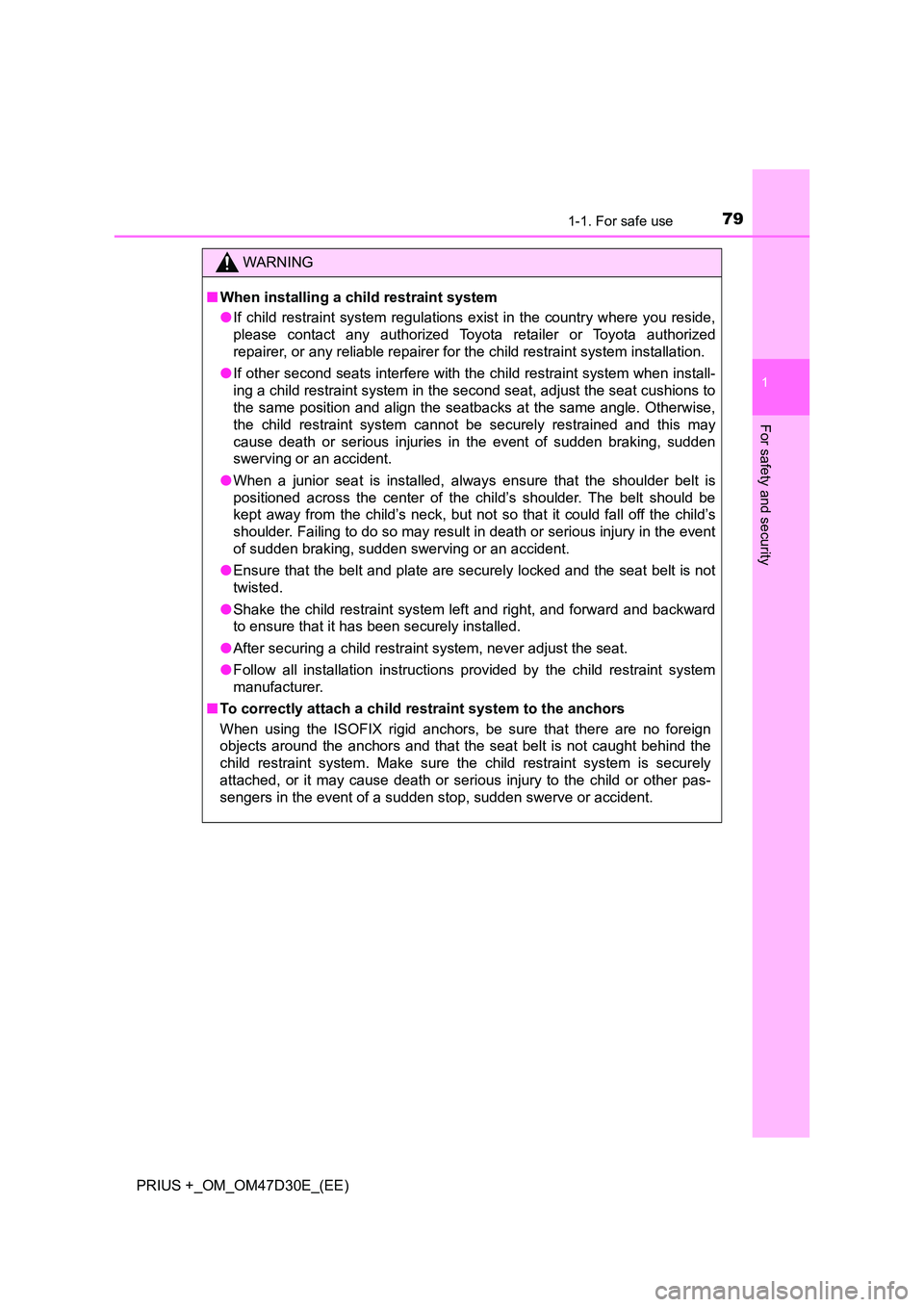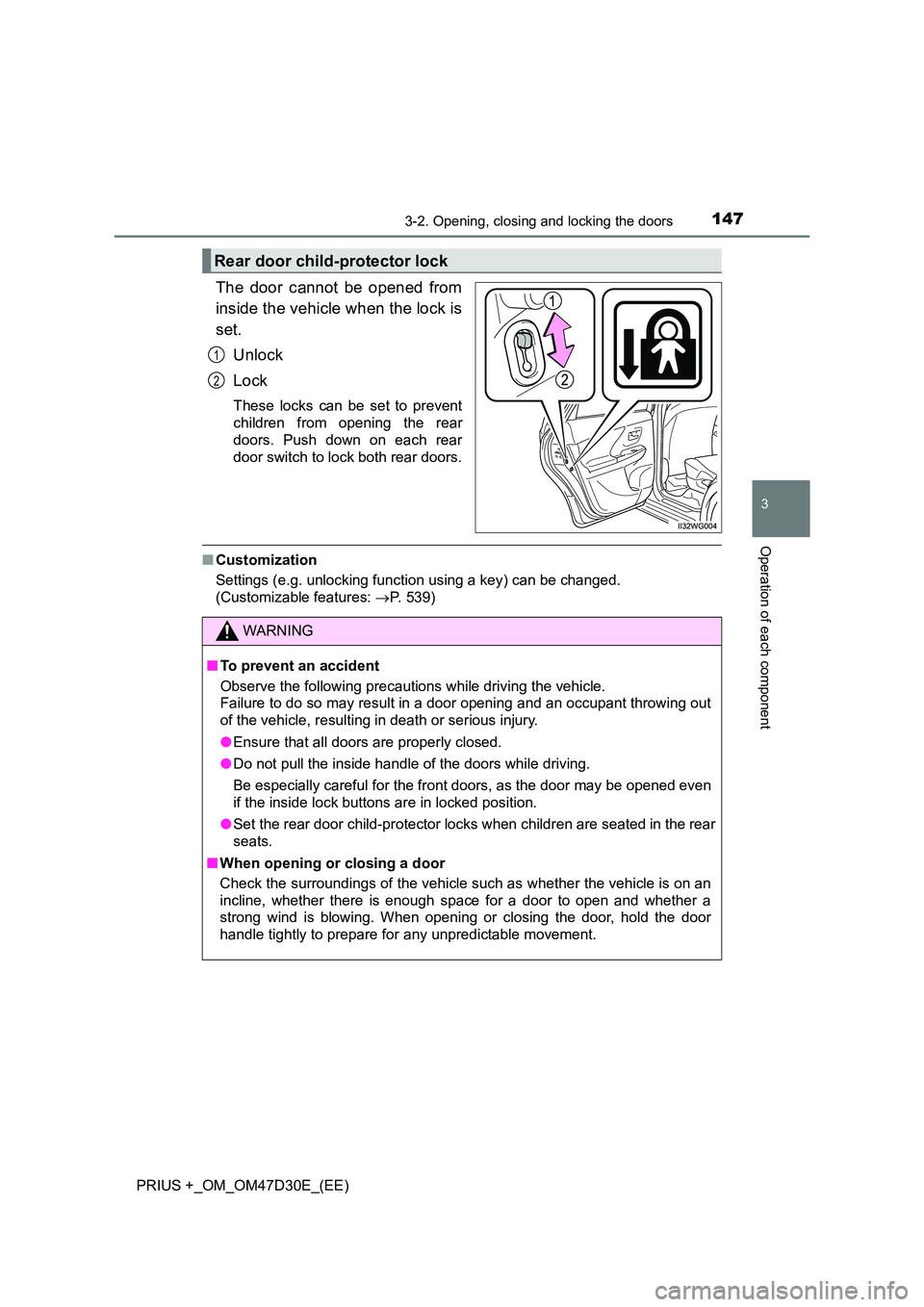Page 72 of 568
721-1. For safe use
PRIUS +_OM_OM47D30E_(EE)
■Junior seat
Adjusting the angle of the seatback.
Second seats
While pulling the lever (either
[outboard seats only] or
), fold the seatback for-
ward and then back to the 1st
lock position (most upright
position) until it locks into
place. Adjust the seatback to
the 5th lock position.
1st lock position
5th lock position
Move the seat as far back as
possible.
Third seats
Adjust the second seat for-
ward so that it does not inter-
fere with the child restraint
system.
While pulling the lever, fold
the seatback forward and
then back to the 1st lock
position (most upright posi-
tion) until it locks into place.
1
1
2
A
B
Page 74 of 568
741-1. For safe use
PRIUS +_OM_OM47D30E_(EE)
Adjusting the angle of the seatback.
While pulling the lever (either
or ), fold the seatback for-
ward and then back to the 1st
lock position (most upright posi-
tion) until it locks into place.
Adjust the seatback to the 5th
lock position.
1st lock position
5th lock position
Move the seat as far back as
possible.
Remove the head restraint. ( P. 200)
Installation with ISOFIX rigid anchor (ISOFIX child restraint sys-
tem) (second outboard seats only)
1
12
A
B
2
Page 76 of 568
761-1. For safe use
PRIUS +_OM_OM47D30E_(EE)
Latch the hook onto the anchor
bracket and tighten the top strap.
Make sure the top strap is securely
latched.
■ When installing a child restraint system
You need a locking clip to install the child restraint system. Follow the instruc-
tions provided by the manufacturer of the system. If your child restraint sys-
tem does not provide a locking clip, you can purchase the following item from
any authorized Toyota retailer or Toyota authorized repairer, or any reliable
repairer:
Locking clip for child restraint system
(Part No. 73119-22010)
Child restraint systems with a top strap (second outboard seats
only)
Page 79 of 568

791-1. For safe use
1
PRIUS +_OM_OM47D30E_(EE)
For safety and security
WARNING
■When installing a child restraint system
● If child restraint system regulations exist in the country where you reside,
please contact any authorized Toyota retailer or Toyota authorized
repairer, or any reliable repairer for the child restraint system installation.
● If other second seats interfere with the child restraint system when install-
ing a child restraint system in the second seat, adjust the seat cushions to
the same position and align the seatbacks at the same angle. Otherwise,
the child restraint system cannot be securely restrained and this may
cause death or serious injuries in the event of sudden braking, sudden
swerving or an accident.
● When a junior seat is installed, always ensure that the shoulder belt is
positioned across the center of the child’s shoulder. The belt should be
kept away from the child’s neck, but not so that it could fall off the child’s
shoulder. Failing to do so may result in death or serious injury in the event
of sudden braking, sudden swerving or an accident.
● Ensure that the belt and plate are securely locked and the seat belt is not
twisted.
● Shake the child restraint system left and right, and forward and backward
to ensure that it has been securely installed.
● After securing a child restraint system, never adjust the seat.
● Follow all installation instructions provided by the child restraint system
manufacturer.
■ To correctly attach a child restraint system to the anchors
When using the ISOFIX rigid anchors, be sure that there are no foreign
objects around the anchors and that the seat belt is not caught behind the
child restraint system. Make sure the child restraint system is securely
attached, or it may cause death or serious injury to the child or other pas-
sengers in the event of a sudden stop, sudden swerve or accident.
Page 84 of 568

841-2. Hybrid system
PRIUS +_OM_OM47D30E_(EE)
■ Sounds and vibrations specific to a hybrid vehicle
There may be no engine sound or vibration even though the vehicle is able to
move with the “READY” indicator is illuminated. For safety, apply the parking
brake and make sure to shift the shift position to P when parked.
The following sounds or vibrations may occur when the hybrid system is
operating and are not a malfunction:
● Motor sounds may be heard from the engine compartment.
● Sounds may be heard from the hybrid battery (traction battery) when the
hybrid system starts or stops.
● Relay operating sounds such as a snap or soft clank will be emitted from the
hybrid battery (traction battery), behind the rear seats, when the hybrid sys-
tem is started or stopped.
● Sounds from the hybrid system may be heard when the back door is open.
● Sounds may be heard from the transmission when the gasoline engine
starts or stops, when driving at low speeds, or during idling.
● Engine sounds may be heard when accelerating sharply.
● Sounds may be heard due to regenerative braking when the brake pedal is
depressed or as the accelerator pedal is released.
● Vibration may be felt when the gasoline engine starts or stops.
● Cooling fan sounds may be heard from the air intake vent under the right-
hand front seat.
■ Maintenance, repair, recycling, and disposal
Contact any authorized Toyota retailer or Toyota authorized repairer, or any
reliable repairer regarding maintenance, repair, recycling and disposal. Do
not dispose of the vehicle yourself.
Page 139 of 568
139
3
Operation of
each component
PRIUS +_OM_OM47D30E_(EE)3-1. Key information
Keys ................................... 140
3-2. Opening, closing and
locking the doors
Side doors.......................... 144
Back door........................... 148
Smart entry & start
system ............................. 153
3-3. Adjusting the seats
Front seats ......................... 187
Second seats ..................... 191
Third seats ......................... 196
Head restraints .................. 199
3-4. Adjusting the steering
wheel and mirrors
Steering wheel ................... 202
Inside rear view mirror ....... 204
Outside rear view
mirrors ............................. 206
3-5. Opening and closing the
windows
Power windows .................. 208
Page 147 of 568

1473-2. Opening, closing and locking the doors
3
Operation of each component
PRIUS +_OM_OM47D30E_(EE)
The door cannot be opened from
inside the vehicle when the lock is
set.
Unlock
Lock
These locks can be set to prevent
children from opening the rear
doors. Push down on each rear
door switch to lock both rear doors.
■ Customization
Settings (e.g. unlocking function using a key) can be changed.
(Customizable features: P. 539)
Rear door child-protector lock
1
2
WARNING
■To prevent an accident
Observe the following precautions while driving the vehicle.
Failure to do so may result in a door opening and an occupant throwing out
of the vehicle, resulting in death or serious injury.
● Ensure that all doors are properly closed.
● Do not pull the inside handle of the doors while driving.
Be especially careful for the front doors, as the door may be opened even
if the inside lock buttons are in locked position.
● Set the rear door child-protector locks when children are seated in the rear
seats.
■ When opening or closing a door
Check the surroundings of the vehicle such as whether the vehicle is on an
incline, whether there is enough space for a door to open and whether a
strong wind is blowing. When opening or closing the door, hold the door
handle tightly to prepare for any unpredictable movement.
Page 187 of 568
187
3
3-3. Adjusting the seats
Operation of each component
PRIUS +_OM_OM47D30E_(EE)
Front seats
Manual seat
Seat position adjustment lever
Seatback angle adjustment
lever
Vertical height adjustment lever
(for driver’s side)
Lumbar support adjustment
switch (for driver’s side)
Power seat (if equipped for driver’s side)
Seat position adjustment switch
Seat cushion (front) angle
adjustment switch
Vertical height adjustment
switch
Seatback angle adjustment
switch
Lumbar support adjustment
switch
Adjustment procedure
1
2
3
4
1
2
3
4
5